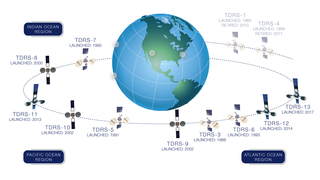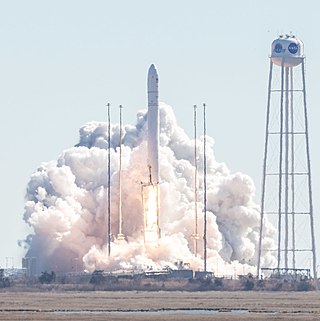Related Research Articles

An Earth observation satellite or Earth remote sensing satellite is a satellite used or designed for Earth observation (EO) from orbit, including spy satellites and similar ones intended for non-military uses such as environmental monitoring, meteorology, cartography and others. The most common type are Earth imaging satellites, that take satellite images, analogous to aerial photographs; some EO satellites may perform remote sensing without forming pictures, such as in GNSS radio occultation.

The Canadian Space Agency is the national space agency of Canada, established in 1990 by the Canadian Space Agency Act.

The Compton Gamma Ray Observatory (CGRO) was a space observatory detecting photons with energies from 20 keV to 30 GeV, in Earth orbit from 1991 to 2000. The observatory featured four main telescopes in one spacecraft, covering X-rays and gamma rays, including various specialized sub-instruments and detectors. Following 14 years of effort, the observatory was launched from Space Shuttle Atlantis during STS-37 on April 5, 1991, and operated until its deorbit on June 4, 2000. It was deployed in low Earth orbit at 450 km (280 mi) to avoid the Van Allen radiation belt. It was the heaviest astrophysical payload ever flown at that time at 16,300 kilograms (35,900 lb).

LAGEOS, Laser Geodynamics Satellite or Laser Geometric Environmental Observation Survey, are a series of two scientific research satellites designed to provide an orbiting laser ranging benchmark for geodynamical studies of the Earth. Each satellite is a high-density passive laser reflector in a very stable medium Earth orbit (MEO).

The Defense Meteorological Satellite Program (DMSP) monitors meteorological, oceanographic, and solar-terrestrial physics for the United States Department of Defense. The program is managed by the United States Space Force with on-orbit operations provided by the National Oceanic and Atmospheric Administration (NOAA). The mission of the satellites was revealed in March 1973. They provide cloud cover imagery from polar orbits that are Sun-synchronous at nominal altitude of 830 km (520 mi).

The Interim Control Module (ICM) is a NASA-constructed module designed to serve as a temporary "tug" for the International Space Station in case the Zvezda service module was destroyed or not launched for an extended period of time. It was derived from a formerly-classified Titan Launch Dispenser used to distribute reconnaissance satellites to different orbits. It would have been able to prolong the lifespan of the Zarya module by providing equivalent propulsion capabilities to the Service Module, although not any of the other life support capabilities.
In 1997 NASA requested that the Naval Research Laboratory study the feasibility of adapting an existing, heritage spaceflight system to provide low-cost, contingency propulsion operations for the International Space Station (ISS).
After determining that the system could be adapted in time to meet NASA's schedule requirements, NRL was granted authority to proceed with the Interim Control Module (ICM). From its inception ICM was a contingency option for attitude control and reboost of the ISS that would allow NASA to preserve the on-orbit construction schedule in case of delays in the launch of the Russian Service Module.
ICM was to launch on board the Space Shuttle, deploy from the Shuttle's cargo bay, and mate with the ISS at the Russian Control Module. Once on orbit ICM would provide sufficient fuel for one to three years of operation.

The ISS Propulsion module, functions performed by the Zvezda Service Module and Progress spacecraft. Critical ISS functionality such as guidance, navigation, control and propulsion are provided only by Russian and the European (ATV) spacecraft. A Propulsion Module would have been needed for ISS altitude maintenance and reboost, debris avoidance maneuvers, attitude control and propellant supply in the event the Zvezda Service Module was not available to the International Space Station. If the Zvezda had not been available, the Interim Control Module would have been used at first. It only had a lifetime of three years; then the Propulsion Module would have been necessary.

A tracking and data relay satellite (TDRS) is a type of communications satellite that forms part of the Tracking and Data Relay Satellite System (TDRSS) used by NASA and other United States government agencies for communications to and from independent "User Platforms" such as satellites, balloons, aircraft, the International Space Station, and remote bases like the Amundsen-Scott South Pole Station. This system was designed to replace an existing worldwide network of ground stations that had supported all of NASA's crewed flight missions and uncrewed satellites in low-Earth orbits. The primary system design goal was to increase the amount of time that these spacecraft were in communication with the ground and improve the amount of data that could be transferred. These TDRSS satellites are all designed and built to be launched to and function in geosynchronous orbit, 35,786 km (22,236 mi) above the surface of the Earth.
This is a timeline of space exploration which includes notable achievements, first accomplishments and milestones in humanity's exploration of outer space.

The European Retrievable Carrier (EURECA) was an uncrewed 4.5-tonne satellite with 15 experiments. It was a European Space Agency (ESA) mission and the acronym was derived from Archimedes' bathtub revelation "Eureka!".

The National Aeronautics and Space Administration is an independent agency of the U.S. federal government responsible for the civil space program, aeronautics research, and space research. Established in 1958, NASA succeeded the National Advisory Committee for Aeronautics (NACA) to give the U.S. space development effort a distinctly civilian orientation, emphasizing peaceful applications in space science. NASA has since led most American space exploration, including Project Mercury, Project Gemini, the 1968–1972 Apollo Moon landing missions, the Skylab space station, and the Space Shuttle. NASA currently supports the International Space Station and oversees the development of the Orion spacecraft and the Space Launch System for the crewed lunar Artemis program, the Commercial Crew spacecraft, and the planned Lunar Gateway space station.
Orion 3 was an American spacecraft which was intended for use by Orion Network Systems, as a geostationary communications satellite. It was to have been positioned in geostationary orbit at a longitude of 139° East, from where it was to have provided communications services to Asia and Oceania. Due to a malfunction during launch, it was instead delivered to a useless low Earth orbit.

The NASA Launch Services Program (LSP) is responsible for procurement of launch services for NASA uncrewed missions and oversight of launch integration and launch preparation activity, providing added quality and mission assurance to meet program objectives. LSP operates under the NASA Space Operations Mission Directorate (SOMD).

Progress M-11M, identified by NASA as Progress 43P, is a Progress spacecraft which was launched on 21 June 2011 to resupply the International Space Station. It was the eleventh Progress-M 11F615A60 spacecraft to be launched. The spacecraft is manufactured by RKK Energia, and will be operated by the Russian Federal Space Agency. Progress M-11M transferred more than 2500 kg of cargo to the Space Station, including food, water, scientific hardware, propellant, and cargo for the Russian Federal Space Agency (Roscosmos), NASA and the Japanese Space Agency, (JAXA).

Progress M-12M, identified by NASA as Progress 44P, was an uncrewed Progress spacecraft that was lost in a launch failure on 24 August 2011, at the start of a mission to resupply the International Space Station. It was the twelfth modernised Progress-M spacecraft to be launched. Manufactured by RKK Energia, the spacecraft was to have been operated by the Russian Federal Space Agency.

SpaceX CRS-4, also known as SpX-4, was a Commercial Resupply Service mission to the International Space Station (ISS), contracted to NASA, which was launched on 21 September 2014 and arrived at the space station on 23 September 2014. It was the sixth flight for SpaceX's uncrewed Dragon cargo spacecraft, and the fourth SpaceX operational mission contracted to NASA under a Commercial Resupply Services contract. The mission brought equipment and supplies to the space station, including the first 3D printer to be tested in space, a device to measure wind speed on Earth, and small satellites to be launched from the station. It also brought 20 mice for long-term research aboard the ISS.

Planet Labs PBC is an American public Earth imaging company based in San Francisco, California. Their goal is to image the entirety of the Earth daily to monitor changes and pinpoint trends.

Progress M-26M, identified by NASA as Progress 58P, is a Progress spacecraft used by Roskosmos to resupply the International Space Station (ISS) during 2015. Progress M-26M was launched on a six-hours rendezvous profile towards the ISS. The 26th Progress-M 11F615A60 spacecraft to be launched, it had the serial number 426 and was built by RKK Energia.

Cygnus NG-17, previously known as Cygnus OA-17, was the seventeenth flight of the Northrop Grumman robotic resupply spacecraft Cygnus and its sixteenth flight to the International Space Station (ISS) under the Commercial Resupply Services (CRS) contract with NASA. The mission launched on 19 February 2022 at 17:40:03 UTC. It was the sixth launch of Cygnus under the CRS-2 contract.
References
- ↑ Stewart, Robert W. (1992-05-15). "Rocket Blasts Satellite Toward a Proper Orbit". Los Angeles Times . Retrieved 2017-01-05.
- ↑ "STS-49 (Intelsat/Asem) Mission Profile". NASA.gov. NASA . Retrieved 2017-01-05.
- 1 2 Savage, Donald L.; Finneran, Michael. "NASA Succeeds with Gamma-Ray Observatory Reboost". NASA.gov. Washington, D.C.: NASA. p. 2. Retrieved 2017-01-05.